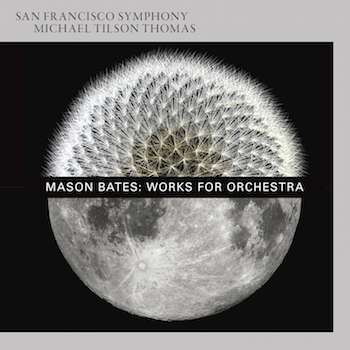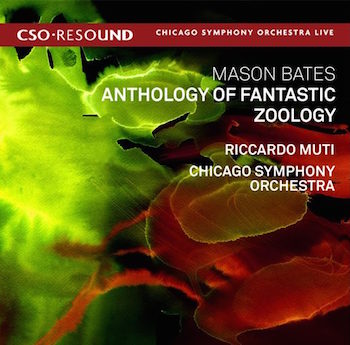CD Reviews: Orchestral Music by Mason Bates — A Welcome Addition to the Canon.
Nothing’s too high-brow for Mason Bates. His music isn’t afraid to smile. If it doesn’t always run deep, it’s at least always engaging and pleasant to encounter.
Orchestral Music by Mason Bates (BMOP/Sound, SFS Media, CSO Resound)

Mason Bates — a composer who has broken into the big time.
By Jonathan Blumhofer
Writing for orchestra is a tough business. First of all, you’ve got to break into the repertoire. More than that, rehearsal time – especially for new music – comes at a major premium. And, if you can manage your way through those two obstacles, making a positive-enough impression on conductors, musicians, and audiences is never a sure thing.
But in recent years, a handful of young composers have done just that and made it look easy. One of them is Mason Bates (b.1977), who’s got three albums by three of the country’s best ensembles – the San Francisco (SFO) and Chicago Symphonies (CSO), and the Boston Modern Orchestra Project (BMOP) – out this year. What’s to be said about the results? Well, there’s some unevenness in quality here and there but, on the whole, Bates has navigated the trifecta of challenges on his own terms and his is, by and large, a welcome addition to the canon.
Trained at Juilliard, Columbia, and UC-Berkeley, perhaps Bates’ biggest claim to fame is the fact that, in addition to writing concert music, he’s active as a DJ. Nothing’s too high-brow for him. His music isn’t afraid to smile. If it doesn’t always run deep, it’s at least always engaging and pleasant to encounter.
Such is the case with BMOP’s Mothership, a collection of five Bates scores written between 2006 and 2013. Some of it’s just carefree fun: the eponymous opening track, for instance, is a blend of pulsing rhythms; striking orchestral colors; and swooning, lyrical riffs interspersed by a series of instrumental solos. In Rusty Air in Carolina, Bates crafted some striking evocations of place – muted brass gurgling like bullfrogs under the dripping sweat of high strings and the incessant rattle of shakers and electronics – that all but exudes sweltering, Southern humidity. When, eventually, a sultry, languorous melody emerges, it’s almost as though The Chairman Dances has come to Charleston.

Sea-Blue Circuitry attempts to fuse the influence of big-band jazz and Minimalism. Elements of both can be heard rather easily, though the piece as a whole lacks the rhythmic and melodic confidence of Mothership. The same can be said for Attack Decay Sustain Release and Desert Transport, which comprise the rest of the disc. The former, a short concert-opener, builds to a dramatic, Glass-ian climax (replete with lots of snare drum), but fails to leave much of an impression. The latter, at least, includes a snatch of a field recording of Pima Indians singing, which helps it stand out among its neighbors here.
Still, this isn’t music that necessarily offends by these flaws, though Bates’ musical language does have its shortcomings. The most pronounced of them – namely, a lack of melodic and emotional variety, piece-to-piece, and the sense that the music’s best moments are simply rehashing the music of other composers (mostly John Adams) – are evident on the SFS’s disc, Works for Orchestra. With one exception, though, it’s possible to look past (or accept) most of these problems for the greater good.
That anomaly is Works’ closing piece, Alternative Energy, a four-movement “energy-symphony” that’s quite simply forgettable. Its main problem is that it’s concept-music whose underlying idea (tracing energy through music) simply isn’t supported by the materials at hand. There’s a lot going on, especially in the electronics – recordings from the Fermilab particle collider and hip-hop beats, among others – plus a myriad of musical styles (including some fiddling, thudding club beats, and Minimalist riffs) that try, but don’t manage, to add up to a coherent whole.

A similar problem affects parts of The B-Sides, perhaps Bates’ best-known calling card. Stretches of it, especially in the middle, meander. But, once you make it through to the finale, “Warehouse Medicine,” the piece wraps up with such an irresistible romp that it’s hard not to forgive its earlier weaknesses. Schoenberg’s Five Pieces (from which The B-Sides takes its inspiration) may speak with more force, but there’s no way you’re walking into intermission whistling “Das obligate Rezitativ.”
The best piece on this album is Liquid Interface, an engrossing bit of musical ecology that traces an arc from “Glaciers Calving” and “Crescent City” (a nod to New Orleans) to “On the Wannsee.” Acoustic instruments and electronics blend subtly and effectively, often depicting the destructive power of water. In “Crescent City,” Bates really proves his chops, moving seamlessly from his decidedly post-Minimalist aesthetic into the world of big-band jazz and Dixieland. It’s so fluent and elegant a gesture – the sort of thing you might expect Leonard Bernstein to pull off – and it comes up so unexpectedly that it’s one of the best individual movements on any of these three discs.
That said, of this triumvirate of albums, the most impressive piece is the most recent, 2015’s Anthology of Fantastic Zoology. A concerto for orchestra inspired by Jorge Luis Borga’s slender book of the same title, the piece offered Bates the opportunity to try out any number of orchestrational ideas. And, given its division into ten discreet (but connected) movements, there’s a nice focus to his writing in it.

Much of the time the music gambols. “Sprite” tosses off increasingly-accented riffs between winds and strings with percussive gestures coloring the scene; eventually, an episode not too-distantly related to Copland’s Danzón Cubano takes off. A similar thing happens in “The A Bao A Qu,” with its delicious low-wind refrains and Stravinsky-ian brass interjections; at the end, there’s a nice nod to Sensemaya. “Nymphs” channels Debussy and Ravel a bit, with its delicate string textures and gentle woodwind filigrees. Bates’ take on the traditional pairing of brass and timpani is thoroughly enlivening in “The Gryphon” and, in “Sirens,” he crafts a beguiling tapestry of resonant percussion and offstage violins. The finale, “Madrugada,” offers something of a recapitulation of all that’s gone on before, and ends everything in a blaze of light.
Through it all, Riccardo Muti – known more for his superb Verdi interpretations rather than his sympathy for contemporary music – draws a brilliant performance from the CSO. This is a fearlessly virtuosic orchestra and they play the Bates with no holds barred and driving force.
Much the same can be said for BMOP’s Mothership and the direction of Gil Rose. This disc is as impressive and well-played as any recording they’ve turned out and, considering the breadth of BMOP/Sound’s discography – spanning Arthur Berger and Milton Babbitt to David Rakowski, Andrew Norman, and Reza Vali – stands as a reminder of just how vital a niche it is that the ensemble fills.
But, for sheer character and excellence in playing, the prize must go to Michael Tilson Thomas and the SFS. Like the CSO, they’re fully at home in the bread-and-butter of the repertoire and they play Bates like he’s part of it. The quality, color, and vigor of their performances are as fine and rehearsed as they are in their readings of Berlioz, Mahler, and Stravinsky. Simply put, Works for Orchestra, some uneven compositional moments notwithstanding, sets the bar by which all top-tier orchestras that play contemporary music ought to be measured.
Jonathan Blumhofer is a composer and violist who has been active in the greater Boston area since 2004. His music has received numerous awards and been performed by various ensembles, including the American Composers Orchestra, Kiev Philharmonic, Camerata Chicago, Xanthos Ensemble, and Juventas New Music Group. Since receiving his doctorate from Boston University in 2010, Jon has taught at Clark University, Worcester Polytechnic Institute, and online for the University of Phoenix, in addition to writing music criticism for the Worcester Telegram & Gazette.
Tagged: BMOP/sound, CSO Resound, Mason Bates, orchestral music

His kinetic, dynamic orchestral conception and electronic fusion jumps out of the speaker in multiple dimensions.